Research Proposal: Managing Cultural Diversity in the Workplace
VerifiedAdded on 2023/01/13
|10
|1746
|80
Project
AI Summary
This research proposal investigates the effective management of cultural diversity in the workplace, using ASDA as a case study. The study aims to define cultural diversity, identify its benefits, explore related challenges, and recommend improvement strategies. The research employs a mixed-methods approach, combining qualitative and quantitative techniques, with Interpretivism as the research philosophy. Data collection includes surveys and secondary research from books, articles, and journals. The proposal outlines a detailed timeline, including data collection, analysis, and formatting. Ethical considerations, such as informed consent and confidentiality, are also addressed. The research is designed to provide insights into how organizations can leverage cultural diversity to improve productivity and foster a more inclusive work environment. The study will use thematic data analysis to interpret the collected data.
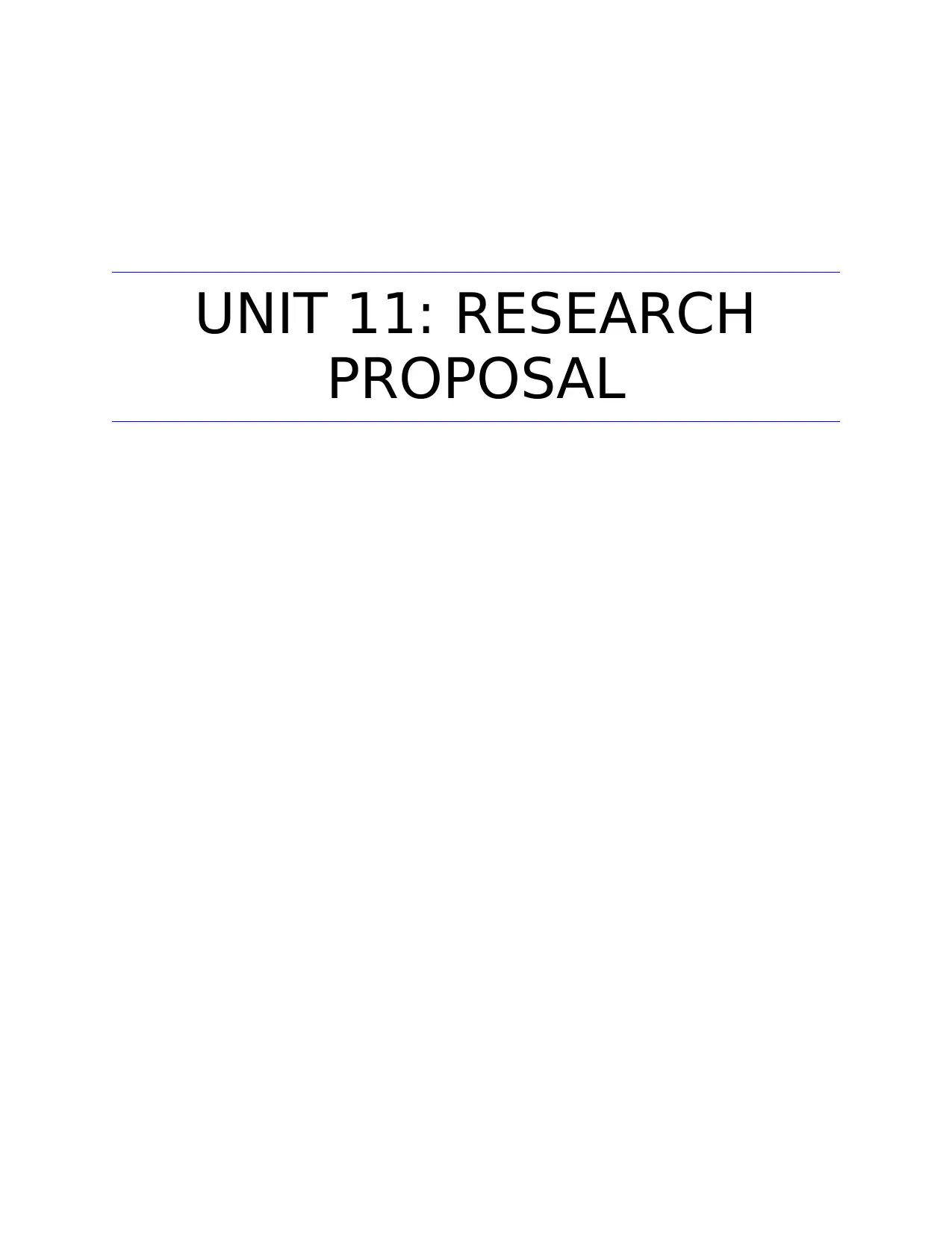
UNIT 11: RESEARCH
PROPOSAL
PROPOSAL
Paraphrase This Document
Need a fresh take? Get an instant paraphrase of this document with our AI Paraphraser
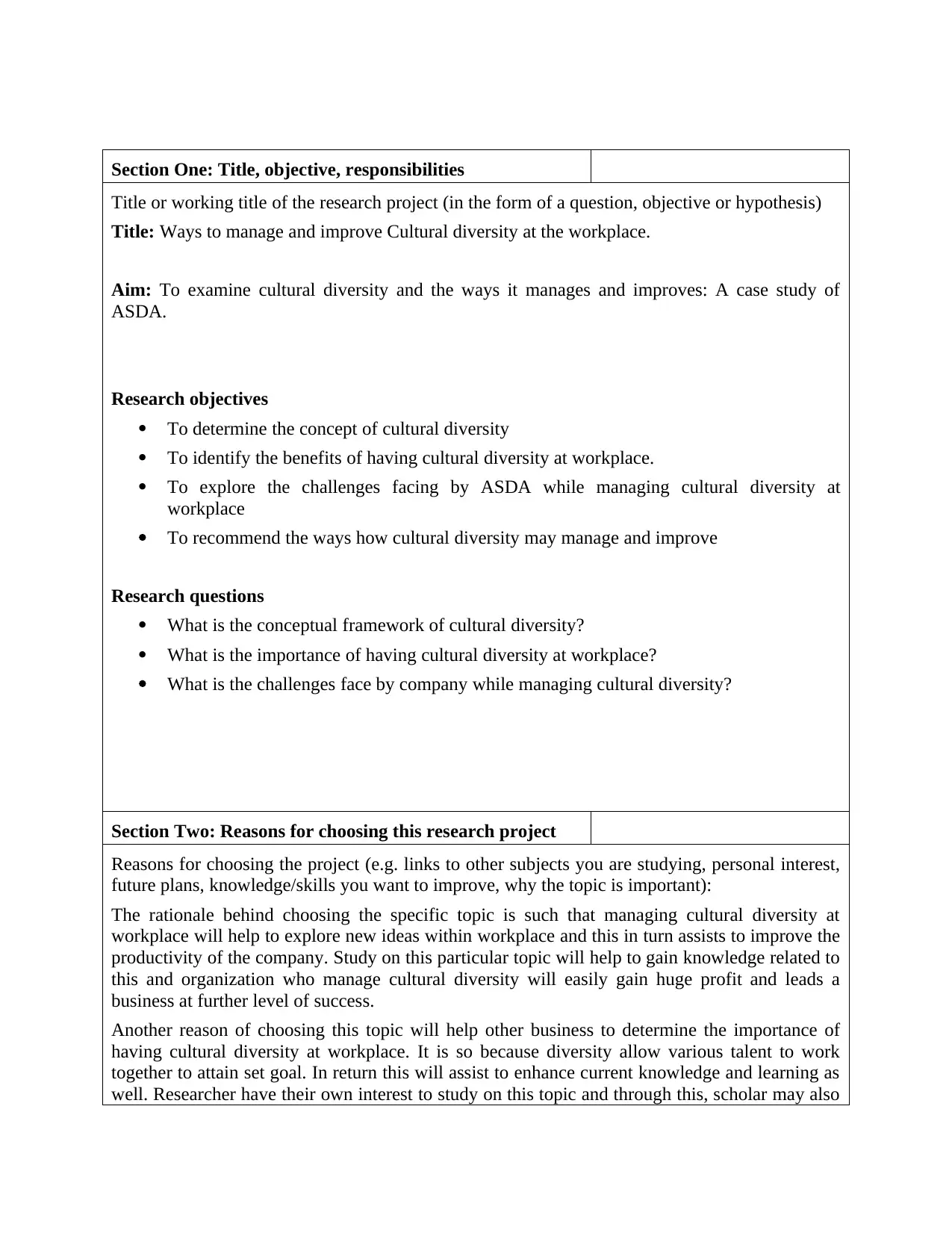
Section One: Title, objective, responsibilities
Title or working title of the research project (in the form of a question, objective or hypothesis)
Title: Ways to manage and improve Cultural diversity at the workplace.
Aim: To examine cultural diversity and the ways it manages and improves: A case study of
ASDA.
Research objectives
To determine the concept of cultural diversity
To identify the benefits of having cultural diversity at workplace.
To explore the challenges facing by ASDA while managing cultural diversity at
workplace
To recommend the ways how cultural diversity may manage and improve
Research questions
What is the conceptual framework of cultural diversity?
What is the importance of having cultural diversity at workplace?
What is the challenges face by company while managing cultural diversity?
Section Two: Reasons for choosing this research project
Reasons for choosing the project (e.g. links to other subjects you are studying, personal interest,
future plans, knowledge/skills you want to improve, why the topic is important):
The rationale behind choosing the specific topic is such that managing cultural diversity at
workplace will help to explore new ideas within workplace and this in turn assists to improve the
productivity of the company. Study on this particular topic will help to gain knowledge related to
this and organization who manage cultural diversity will easily gain huge profit and leads a
business at further level of success.
Another reason of choosing this topic will help other business to determine the importance of
having cultural diversity at workplace. It is so because diversity allow various talent to work
together to attain set goal. In return this will assist to enhance current knowledge and learning as
well. Researcher have their own interest to study on this topic and through this, scholar may also
Title or working title of the research project (in the form of a question, objective or hypothesis)
Title: Ways to manage and improve Cultural diversity at the workplace.
Aim: To examine cultural diversity and the ways it manages and improves: A case study of
ASDA.
Research objectives
To determine the concept of cultural diversity
To identify the benefits of having cultural diversity at workplace.
To explore the challenges facing by ASDA while managing cultural diversity at
workplace
To recommend the ways how cultural diversity may manage and improve
Research questions
What is the conceptual framework of cultural diversity?
What is the importance of having cultural diversity at workplace?
What is the challenges face by company while managing cultural diversity?
Section Two: Reasons for choosing this research project
Reasons for choosing the project (e.g. links to other subjects you are studying, personal interest,
future plans, knowledge/skills you want to improve, why the topic is important):
The rationale behind choosing the specific topic is such that managing cultural diversity at
workplace will help to explore new ideas within workplace and this in turn assists to improve the
productivity of the company. Study on this particular topic will help to gain knowledge related to
this and organization who manage cultural diversity will easily gain huge profit and leads a
business at further level of success.
Another reason of choosing this topic will help other business to determine the importance of
having cultural diversity at workplace. It is so because diversity allow various talent to work
together to attain set goal. In return this will assist to enhance current knowledge and learning as
well. Researcher have their own interest to study on this topic and through this, scholar may also
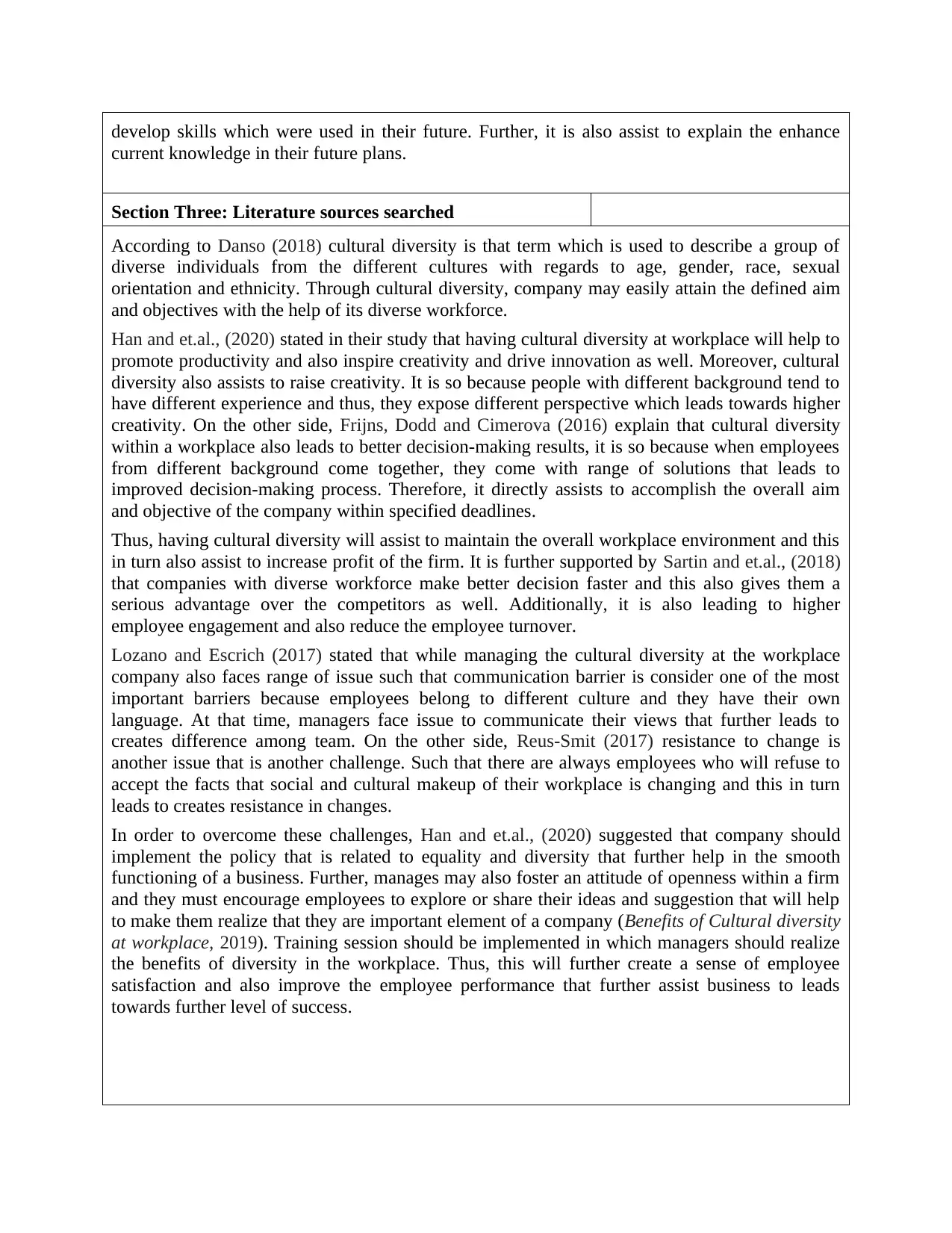
develop skills which were used in their future. Further, it is also assist to explain the enhance
current knowledge in their future plans.
Section Three: Literature sources searched
According to Danso (2018) cultural diversity is that term which is used to describe a group of
diverse individuals from the different cultures with regards to age, gender, race, sexual
orientation and ethnicity. Through cultural diversity, company may easily attain the defined aim
and objectives with the help of its diverse workforce.
Han and et.al., (2020) stated in their study that having cultural diversity at workplace will help to
promote productivity and also inspire creativity and drive innovation as well. Moreover, cultural
diversity also assists to raise creativity. It is so because people with different background tend to
have different experience and thus, they expose different perspective which leads towards higher
creativity. On the other side, Frijns, Dodd and Cimerova (2016) explain that cultural diversity
within a workplace also leads to better decision-making results, it is so because when employees
from different background come together, they come with range of solutions that leads to
improved decision-making process. Therefore, it directly assists to accomplish the overall aim
and objective of the company within specified deadlines.
Thus, having cultural diversity will assist to maintain the overall workplace environment and this
in turn also assist to increase profit of the firm. It is further supported by Sartin and et.al., (2018)
that companies with diverse workforce make better decision faster and this also gives them a
serious advantage over the competitors as well. Additionally, it is also leading to higher
employee engagement and also reduce the employee turnover.
Lozano and Escrich (2017) stated that while managing the cultural diversity at the workplace
company also faces range of issue such that communication barrier is consider one of the most
important barriers because employees belong to different culture and they have their own
language. At that time, managers face issue to communicate their views that further leads to
creates difference among team. On the other side, Reus-Smit (2017) resistance to change is
another issue that is another challenge. Such that there are always employees who will refuse to
accept the facts that social and cultural makeup of their workplace is changing and this in turn
leads to creates resistance in changes.
In order to overcome these challenges, Han and et.al., (2020) suggested that company should
implement the policy that is related to equality and diversity that further help in the smooth
functioning of a business. Further, manages may also foster an attitude of openness within a firm
and they must encourage employees to explore or share their ideas and suggestion that will help
to make them realize that they are important element of a company (Benefits of Cultural diversity
at workplace, 2019). Training session should be implemented in which managers should realize
the benefits of diversity in the workplace. Thus, this will further create a sense of employee
satisfaction and also improve the employee performance that further assist business to leads
towards further level of success.
current knowledge in their future plans.
Section Three: Literature sources searched
According to Danso (2018) cultural diversity is that term which is used to describe a group of
diverse individuals from the different cultures with regards to age, gender, race, sexual
orientation and ethnicity. Through cultural diversity, company may easily attain the defined aim
and objectives with the help of its diverse workforce.
Han and et.al., (2020) stated in their study that having cultural diversity at workplace will help to
promote productivity and also inspire creativity and drive innovation as well. Moreover, cultural
diversity also assists to raise creativity. It is so because people with different background tend to
have different experience and thus, they expose different perspective which leads towards higher
creativity. On the other side, Frijns, Dodd and Cimerova (2016) explain that cultural diversity
within a workplace also leads to better decision-making results, it is so because when employees
from different background come together, they come with range of solutions that leads to
improved decision-making process. Therefore, it directly assists to accomplish the overall aim
and objective of the company within specified deadlines.
Thus, having cultural diversity will assist to maintain the overall workplace environment and this
in turn also assist to increase profit of the firm. It is further supported by Sartin and et.al., (2018)
that companies with diverse workforce make better decision faster and this also gives them a
serious advantage over the competitors as well. Additionally, it is also leading to higher
employee engagement and also reduce the employee turnover.
Lozano and Escrich (2017) stated that while managing the cultural diversity at the workplace
company also faces range of issue such that communication barrier is consider one of the most
important barriers because employees belong to different culture and they have their own
language. At that time, managers face issue to communicate their views that further leads to
creates difference among team. On the other side, Reus-Smit (2017) resistance to change is
another issue that is another challenge. Such that there are always employees who will refuse to
accept the facts that social and cultural makeup of their workplace is changing and this in turn
leads to creates resistance in changes.
In order to overcome these challenges, Han and et.al., (2020) suggested that company should
implement the policy that is related to equality and diversity that further help in the smooth
functioning of a business. Further, manages may also foster an attitude of openness within a firm
and they must encourage employees to explore or share their ideas and suggestion that will help
to make them realize that they are important element of a company (Benefits of Cultural diversity
at workplace, 2019). Training session should be implemented in which managers should realize
the benefits of diversity in the workplace. Thus, this will further create a sense of employee
satisfaction and also improve the employee performance that further assist business to leads
towards further level of success.
⊘ This is a preview!⊘
Do you want full access?
Subscribe today to unlock all pages.

Trusted by 1+ million students worldwide
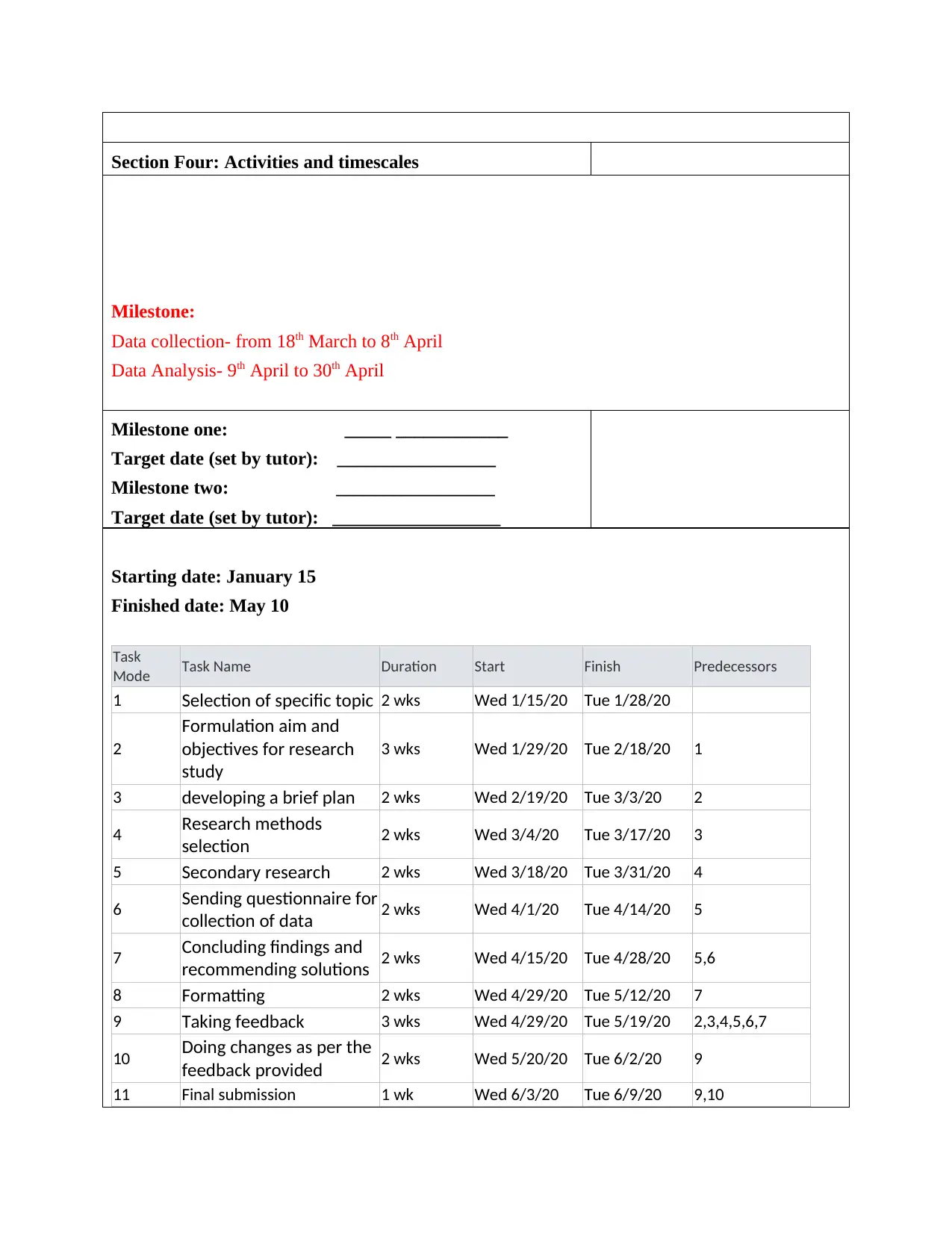
Section Four: Activities and timescales
Milestone:
Data collection- from 18th March to 8th April
Data Analysis- 9th April to 30th April
Milestone one: _____ ____________
Target date (set by tutor): _________________
Milestone two: _________________
Target date (set by tutor): __________________
Starting date: January 15
Finished date: May 10
Task
Mode Task Name Duration Start Finish Predecessors
1 Selection of specific topic 2 wks Wed 1/15/20 Tue 1/28/20
2
Formulation aim and
objectives for research
study
3 wks Wed 1/29/20 Tue 2/18/20 1
3 developing a brief plan 2 wks Wed 2/19/20 Tue 3/3/20 2
4 Research methods
selection 2 wks Wed 3/4/20 Tue 3/17/20 3
5 Secondary research 2 wks Wed 3/18/20 Tue 3/31/20 4
6 Sending questionnaire for
collection of data 2 wks Wed 4/1/20 Tue 4/14/20 5
7 Concluding findings and
recommending solutions 2 wks Wed 4/15/20 Tue 4/28/20 5,6
8 Formatting 2 wks Wed 4/29/20 Tue 5/12/20 7
9 Taking feedback 3 wks Wed 4/29/20 Tue 5/19/20 2,3,4,5,6,7
10 Doing changes as per the
feedback provided 2 wks Wed 5/20/20 Tue 6/2/20 9
11 Final submission 1 wk Wed 6/3/20 Tue 6/9/20 9,10
Milestone:
Data collection- from 18th March to 8th April
Data Analysis- 9th April to 30th April
Milestone one: _____ ____________
Target date (set by tutor): _________________
Milestone two: _________________
Target date (set by tutor): __________________
Starting date: January 15
Finished date: May 10
Task
Mode Task Name Duration Start Finish Predecessors
1 Selection of specific topic 2 wks Wed 1/15/20 Tue 1/28/20
2
Formulation aim and
objectives for research
study
3 wks Wed 1/29/20 Tue 2/18/20 1
3 developing a brief plan 2 wks Wed 2/19/20 Tue 3/3/20 2
4 Research methods
selection 2 wks Wed 3/4/20 Tue 3/17/20 3
5 Secondary research 2 wks Wed 3/18/20 Tue 3/31/20 4
6 Sending questionnaire for
collection of data 2 wks Wed 4/1/20 Tue 4/14/20 5
7 Concluding findings and
recommending solutions 2 wks Wed 4/15/20 Tue 4/28/20 5,6
8 Formatting 2 wks Wed 4/29/20 Tue 5/12/20 7
9 Taking feedback 3 wks Wed 4/29/20 Tue 5/19/20 2,3,4,5,6,7
10 Doing changes as per the
feedback provided 2 wks Wed 5/20/20 Tue 6/2/20 9
11 Final submission 1 wk Wed 6/3/20 Tue 6/9/20 9,10
Paraphrase This Document
Need a fresh take? Get an instant paraphrase of this document with our AI Paraphraser
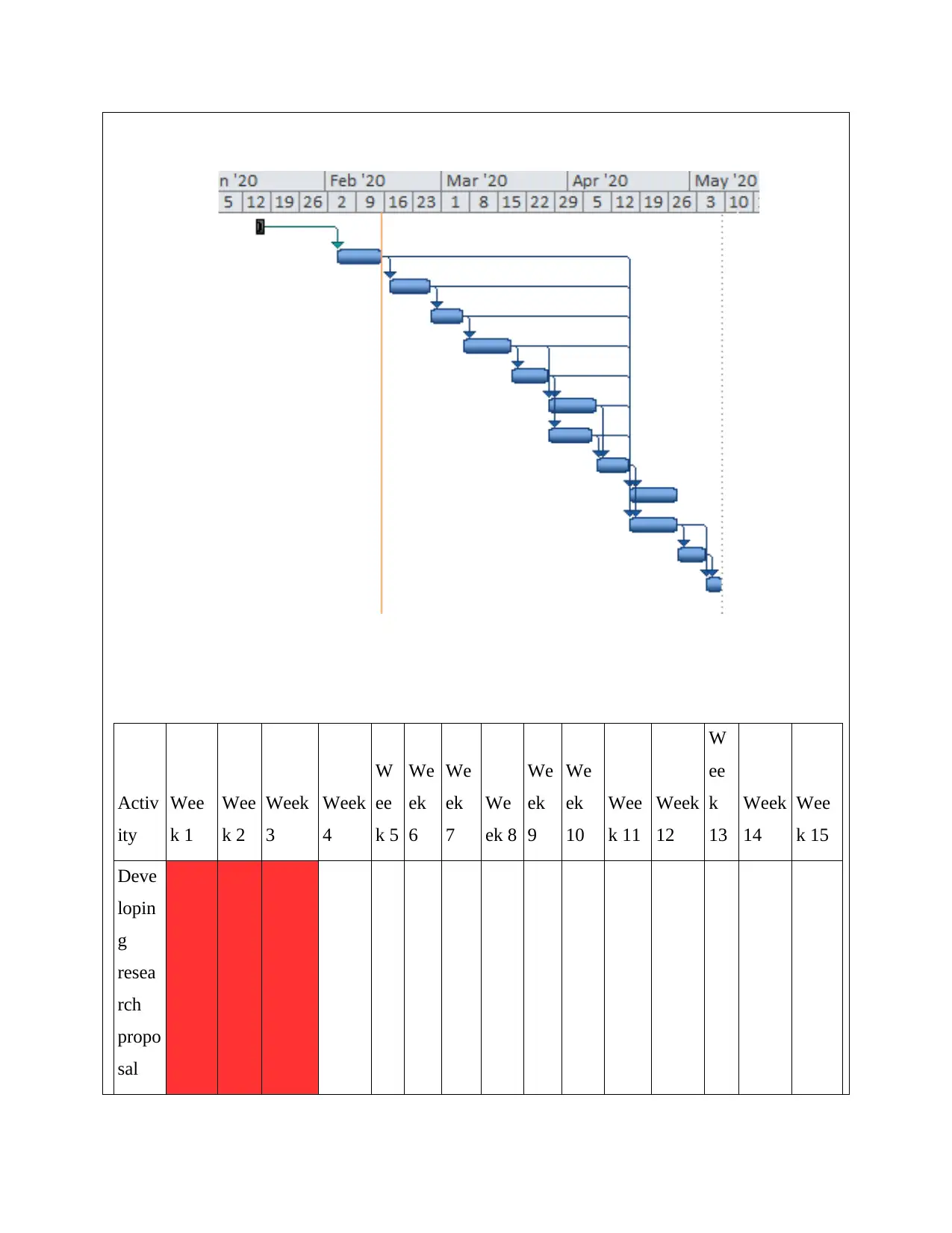
Activ
ity
Wee
k 1
Wee
k 2
Week
3
Week
4
W
ee
k 5
We
ek
6
We
ek
7
We
ek 8
We
ek
9
We
ek
10
Wee
k 11
Week
12
W
ee
k
13
Week
14
Wee
k 15
Deve
lopin
g
resea
rch
propo
sal
ity
Wee
k 1
Wee
k 2
Week
3
Week
4
W
ee
k 5
We
ek
6
We
ek
7
We
ek 8
We
ek
9
We
ek
10
Wee
k 11
Week
12
W
ee
k
13
Week
14
Wee
k 15
Deve
lopin
g
resea
rch
propo
sal
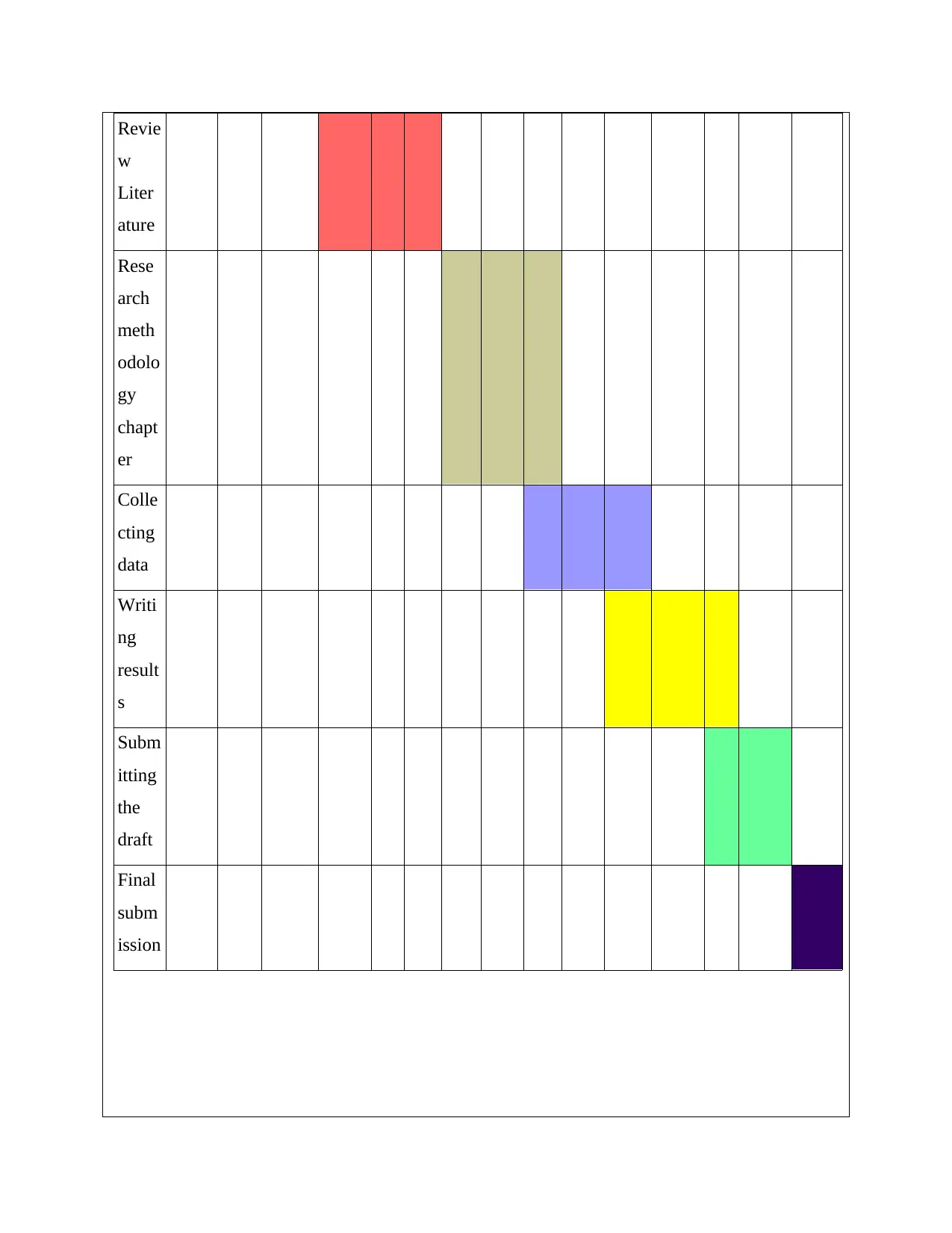
Revie
w
Liter
ature
Rese
arch
meth
odolo
gy
chapt
er
Colle
cting
data
Writi
ng
result
s
Subm
itting
the
draft
Final
subm
ission
w
Liter
ature
Rese
arch
meth
odolo
gy
chapt
er
Colle
cting
data
Writi
ng
result
s
Subm
itting
the
draft
Final
subm
ission
⊘ This is a preview!⊘
Do you want full access?
Subscribe today to unlock all pages.

Trusted by 1+ million students worldwide
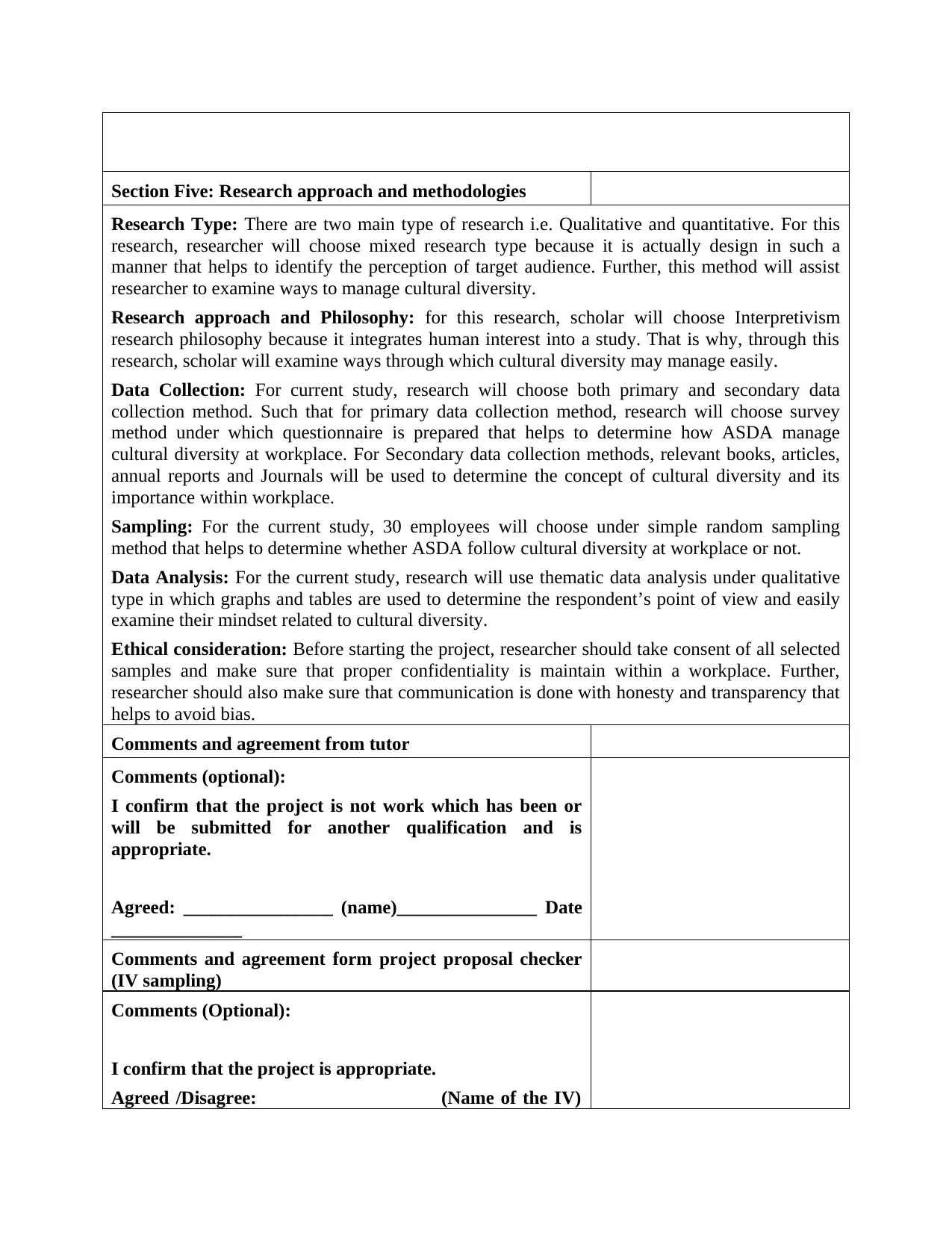
Section Five: Research approach and methodologies
Research Type: There are two main type of research i.e. Qualitative and quantitative. For this
research, researcher will choose mixed research type because it is actually design in such a
manner that helps to identify the perception of target audience. Further, this method will assist
researcher to examine ways to manage cultural diversity.
Research approach and Philosophy: for this research, scholar will choose Interpretivism
research philosophy because it integrates human interest into a study. That is why, through this
research, scholar will examine ways through which cultural diversity may manage easily.
Data Collection: For current study, research will choose both primary and secondary data
collection method. Such that for primary data collection method, research will choose survey
method under which questionnaire is prepared that helps to determine how ASDA manage
cultural diversity at workplace. For Secondary data collection methods, relevant books, articles,
annual reports and Journals will be used to determine the concept of cultural diversity and its
importance within workplace.
Sampling: For the current study, 30 employees will choose under simple random sampling
method that helps to determine whether ASDA follow cultural diversity at workplace or not.
Data Analysis: For the current study, research will use thematic data analysis under qualitative
type in which graphs and tables are used to determine the respondent’s point of view and easily
examine their mindset related to cultural diversity.
Ethical consideration: Before starting the project, researcher should take consent of all selected
samples and make sure that proper confidentiality is maintain within a workplace. Further,
researcher should also make sure that communication is done with honesty and transparency that
helps to avoid bias.
Comments and agreement from tutor
Comments (optional):
I confirm that the project is not work which has been or
will be submitted for another qualification and is
appropriate.
Agreed: ________________ (name)_______________ Date
______________
Comments and agreement form project proposal checker
(IV sampling)
Comments (Optional):
I confirm that the project is appropriate.
Agreed /Disagree: (Name of the IV)
Research Type: There are two main type of research i.e. Qualitative and quantitative. For this
research, researcher will choose mixed research type because it is actually design in such a
manner that helps to identify the perception of target audience. Further, this method will assist
researcher to examine ways to manage cultural diversity.
Research approach and Philosophy: for this research, scholar will choose Interpretivism
research philosophy because it integrates human interest into a study. That is why, through this
research, scholar will examine ways through which cultural diversity may manage easily.
Data Collection: For current study, research will choose both primary and secondary data
collection method. Such that for primary data collection method, research will choose survey
method under which questionnaire is prepared that helps to determine how ASDA manage
cultural diversity at workplace. For Secondary data collection methods, relevant books, articles,
annual reports and Journals will be used to determine the concept of cultural diversity and its
importance within workplace.
Sampling: For the current study, 30 employees will choose under simple random sampling
method that helps to determine whether ASDA follow cultural diversity at workplace or not.
Data Analysis: For the current study, research will use thematic data analysis under qualitative
type in which graphs and tables are used to determine the respondent’s point of view and easily
examine their mindset related to cultural diversity.
Ethical consideration: Before starting the project, researcher should take consent of all selected
samples and make sure that proper confidentiality is maintain within a workplace. Further,
researcher should also make sure that communication is done with honesty and transparency that
helps to avoid bias.
Comments and agreement from tutor
Comments (optional):
I confirm that the project is not work which has been or
will be submitted for another qualification and is
appropriate.
Agreed: ________________ (name)_______________ Date
______________
Comments and agreement form project proposal checker
(IV sampling)
Comments (Optional):
I confirm that the project is appropriate.
Agreed /Disagree: (Name of the IV)
Paraphrase This Document
Need a fresh take? Get an instant paraphrase of this document with our AI Paraphraser

Date

⊘ This is a preview!⊘
Do you want full access?
Subscribe today to unlock all pages.

Trusted by 1+ million students worldwide
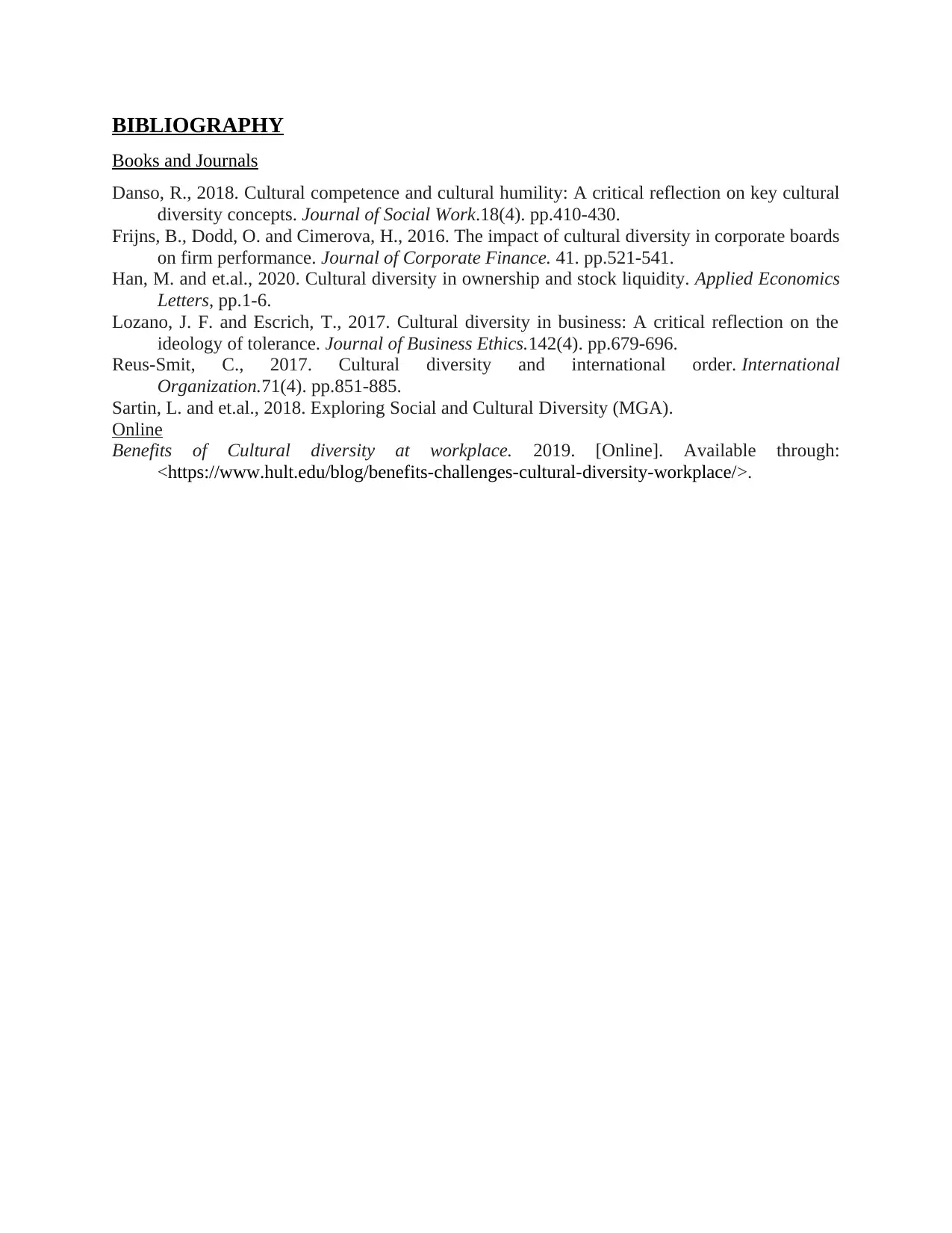
BIBLIOGRAPHY
Books and Journals
Danso, R., 2018. Cultural competence and cultural humility: A critical reflection on key cultural
diversity concepts. Journal of Social Work.18(4). pp.410-430.
Frijns, B., Dodd, O. and Cimerova, H., 2016. The impact of cultural diversity in corporate boards
on firm performance. Journal of Corporate Finance. 41. pp.521-541.
Han, M. and et.al., 2020. Cultural diversity in ownership and stock liquidity. Applied Economics
Letters, pp.1-6.
Lozano, J. F. and Escrich, T., 2017. Cultural diversity in business: A critical reflection on the
ideology of tolerance. Journal of Business Ethics.142(4). pp.679-696.
Reus-Smit, C., 2017. Cultural diversity and international order. International
Organization.71(4). pp.851-885.
Sartin, L. and et.al., 2018. Exploring Social and Cultural Diversity (MGA).
Online
Benefits of Cultural diversity at workplace. 2019. [Online]. Available through:
<https://www.hult.edu/blog/benefits-challenges-cultural-diversity-workplace/>.
Books and Journals
Danso, R., 2018. Cultural competence and cultural humility: A critical reflection on key cultural
diversity concepts. Journal of Social Work.18(4). pp.410-430.
Frijns, B., Dodd, O. and Cimerova, H., 2016. The impact of cultural diversity in corporate boards
on firm performance. Journal of Corporate Finance. 41. pp.521-541.
Han, M. and et.al., 2020. Cultural diversity in ownership and stock liquidity. Applied Economics
Letters, pp.1-6.
Lozano, J. F. and Escrich, T., 2017. Cultural diversity in business: A critical reflection on the
ideology of tolerance. Journal of Business Ethics.142(4). pp.679-696.
Reus-Smit, C., 2017. Cultural diversity and international order. International
Organization.71(4). pp.851-885.
Sartin, L. and et.al., 2018. Exploring Social and Cultural Diversity (MGA).
Online
Benefits of Cultural diversity at workplace. 2019. [Online]. Available through:
<https://www.hult.edu/blog/benefits-challenges-cultural-diversity-workplace/>.
1 out of 10
Related Documents
Your All-in-One AI-Powered Toolkit for Academic Success.
+13062052269
info@desklib.com
Available 24*7 on WhatsApp / Email
![[object Object]](/_next/static/media/star-bottom.7253800d.svg)
Unlock your academic potential
Copyright © 2020–2025 A2Z Services. All Rights Reserved. Developed and managed by ZUCOL.





